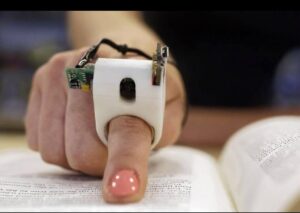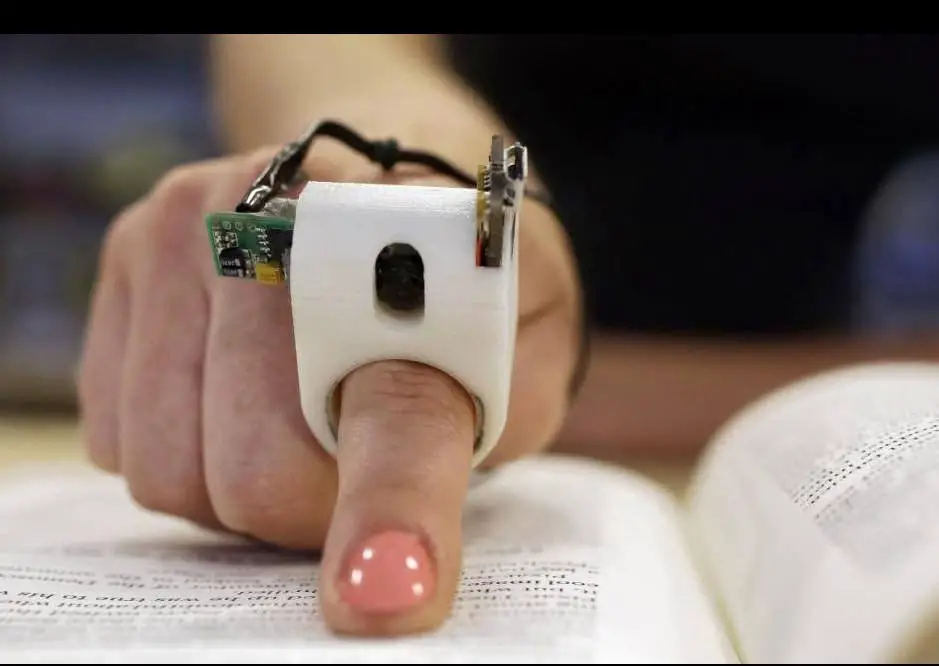“Finger Reader” technology represents a fascinating and highly practical innovation for people with low vision and blindness. It aims to provide real-time audio access to printed text in a way that feels intuitive and mobile.
What is Finger Reader Technology?
The core concept is a wearable device, typically worn on the index finger like an oversized ring, that incorporates a small camera and processing capabilities. As the user moves their finger along a line of printed text (on a book, menu, label, etc.), the device scans the text and converts it into synthesized speech, which is then played aloud to the user (often through an earbud or small speaker).
How Does It Work?
The process involves several key technological components:
- Miniature Camera: A tiny camera mounted on the finger-worn device points downwards, capturing images of the text as the finger moves.
- Optical Character Recognition (OCR): Sophisticated computer vision algorithms are at the heart of the system. Unlike traditional OCR that scans an entire page, the Finger Reader uses real-time, local-sequential scanning. This means it processes text word-by-word or in small chunks as the finger moves.
- Text Processing and Alignment: The algorithms analyze the captured images to:
◦ Identify words and lines: It distinguishes text from background and recognizes individual characters and words.
◦ Track finger movement: It constantly tracks the position of the finger relative to the text.
◦ Maintain alignment: This is a crucial challenge for blind users. The system often provides multimodal feedback (audio and/or haptic/vibration) to guide the user’s finger along a straight line of text. For example:
◦ Audio cues: A tone might increase in pitch or volume if the finger drifts off the line.
◦ Vibrations: Small motors in the device might vibrate to indicate if the finger needs to move up, down, or if it’s reached the end of a line.
- Text-to-Speech (TTS) Engine: Once words are recognized, they are fed into a text-to-speech engine, which synthesizes the words into audible speech in real-time. The goal is to make the spoken output as immediate and natural as possible.
- Connectivity: Early prototypes often connected via a cable to a smartphone or tablet (where the main processing could occur). Newer versions aim for wireless connectivity and more integrated, standalone processing.
Key Features and Benefits for Low Vision and Blind Users:
• Real-Time Reading: Unlike traditional scanners and OCR apps that require scanning an entire page first, the Finger Reader provides immediate audio feedback as the finger moves, making the reading experience more dynamic and interactive.
• Portability and On-the-Go Access: Its small, wearable form factor makes it highly portable, allowing users to read various printed materials in everyday situations – menus in restaurants, labels on products, newspapers, letters, and signs – without needing bulky equipment.
• Intuitive Interface: For many blind individuals, reading with their fingers (e.g., Braille) is a natural mode of interaction. The Finger Reader leverages this tactile familiarity.
• Accessibility to Non-Braille Material: It opens up a vast world of printed text that is not available in Braille, significantly expanding access to information.
• Selective Reading/Skimming: Users can point to specific sections, headlines, or words, allowing for more targeted information access rather than having to listen to an entire page.
• Enhanced Independence: By providing direct and immediate access to printed information, it greatly enhances the independence of visually impaired individuals in various daily tasks.
• Potential for Multipurpose Use: Beyond reading, researchers are exploring its potential for language translation or assisting children with reading difficulties like dyslexia.

Development Status:
The most well-known Finger Reader prototype was developed by researchers at the MIT Media Lab’s Fluid Interfaces Group (led by Roy Shilkrot, Jochen Huber, and Pattie Maes). While the MIT Finger Reader was a groundbreaking proof-of-concept, it and similar technologies are still largely in the developmental or advanced prototype stages. The challenge lies in refining the accuracy, making the devices smaller, more comfortable, fully wireless, affordable for mass production, and robust enough for everyday use.
Other companies like OrCam offer handheld or glasses-mounted devices (e.g., OrCam Read, OrCam My Eye) that provide similar text-to-speech functionalities by pointing or looking at text, though they are not strictly “finger-worn” readers in the same way as the MIT Finger Reader. These are commercially available and represent a broader category of smart reading aids for low vision.
The “Finger Reader” concept holds immense promise for transforming how visually impaired individuals interact with the printed world, offering a more seamless, independent, and intuitive reading experience
by-Hafizul Islam Golder
Discover more from An Eye Care Blog
Subscribe to get the latest posts sent to your email.


You must be logged in to post a comment.